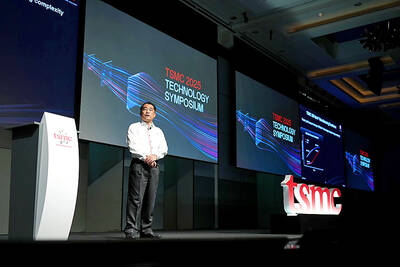Taiwan must tap into the global uncrewed aerial vehicle (UAV) market to obtain the capital necessary to develop a self-sufficient combat drone industry, experts said.
As defense analysts have speculated that China might invade Taiwan in 2027 or 2032, the nation must complete the decoupling of its drone supply chains from China in the next few years, Geosat Aerospace & Technology Inc (經緯航太科技) CEO Lo Cheng-fang (羅正方) said.
The ability to produce combat drones in wartime is crucial for Taiwan’s survival, but the nation’s UAV industry is still in its infancy, said Lo, who is also chairman of the Chiayi-based Asia UAV AI Innovation Application R&D Center.

Photo: CNA
The government should support the domestic industry to ensure Taiwan’s drone supply chains remain unbroken in the event of a military conflict with China, he said.
Drones are an integral part of President William Lai’s (賴清德) Five Trusted Industry Sectors, a category consisting of the semiconductor, artificial intelligence (AI), military, security and surveillance, and next-generation communications industries.
The administration aims to make Taiwan “the Asian hub of UAV supply chains for global democracies,” he said in his inaugural address on May 20.
These supply chains are made of about 40 Taiwanese firms that produce about a dozen drone models altogether, government data showed.
The Taiwanese drone sector was worth an estimated NT$2.86 billion (US$87.15 million) last year, while the global drone industry’s value is expected to reach US$80 billion by 2030.
Chiayi Economic Development Department Director Chiang Zhen-wei (江振瑋) said the global drone industry is split in two, with one side that uses Chinese supply chains and another that does not.
Because of those who have decoupled from China, there is a large opportunity for the domestic drone industry if it is prepared to seize it, he said.
The companies that are part of Chiayi’s drone center represent a complete UAV ecosystem, but the industry would still have to carve out an export market, Chiang said.
The operational costs of automated equipment capable of mass-producing reliable, quality components at scale cannot be funded by the domestic market alone, he added.
Despite Taiwan’s technical prowess, manufacturers cannot be expected to wade into the drone business just to supply domestic demand, said Lo Cheng-ying (駱正穎), a professor of mechanical engineering at National Formosa University.
“Becoming a part of the supply chain for democracies will be crucial going forward,” he said.
National Chung Cheng University strategic studies professor Lin Tai-ho (林泰和) said drones have significant battlefield applications and UAV manufacturing is an industry of ever-increasing importance strategically.
The Taiwanese UAV sector must develop an export market to supplement military contracts, especially as cheaper Chinese parts cannot be used, he said.
The Lai administration made the right call in pursuing the capability to manufacture drones independently of China’s supply chains, even if it is more expensive, Lin added.
Meanwhile, the government would play a key role in coordinating with its industrial partners, Hsuan Yuan Tech Co (璿元科技) CEO Chou Yu-tuan (周玉端) said.
The government must pay attention to industrial requirements in designing projects, as the current approach is leading to the proliferation of non-standard platforms with little commonality, which increases production difficulties and costs, he said.
The contract-issuing bodies of the government frequently demand changes to a project, such as its technical specifications and intended role, further adding to the chaos, he said.
Taiwan Swarm Innovation Inc (臺灣希望創新) CEO Li Chih-ching (李志清) said Washington is looking for allies to replace China in drone supply chains.
Taiwan has the technological capabilities to make drones, but Taiwanese systems are two to three times more expensive than their Chinese counterparts, he said.
Expanding into the global market would enable domestic UAV makers to benefit from the economy of scale and lower their prices to competitive levels, Li said.
However, the Taiwanese UAV sector is unlikely to be competitively priced compared with China, he said, adding the industry should concentrate on making drones for special applications for customers that cannot use systems that have Chinese parts.

DEMOGRAPHICS: Robotics is the most promising answer to looming labor woes, the long-term care system and national contingency response, an official said Taiwan is to launch a five-year plan to boost the robotics industry in a bid to address labor shortages stemming from a declining and aging population, the Executive Yuan said yesterday. The government approved the initiative, dubbed the Smart Robotics Industry Promotion Plan, via executive order, senior officials told a post-Cabinet meeting news conference in Taipei. Taiwan’s population decline would strain the economy and the nation’s ability to care for vulnerable and elderly people, said Peter Hong (洪樂文), who heads the National Science and Technology Council’s (NSTC) Department of Engineering and Technologies. Projections show that the proportion of Taiwanese 65 or older would

Nvidia Corp yesterday unveiled its new high-speed interconnect technology, NVLink Fusion, with Taiwanese application-specific IC (ASIC) designers Alchip Technologies Ltd (世芯) and MediaTek Inc (聯發科) among the first to adopt the technology to help build semi-custom artificial intelligence (AI) infrastructure for hyperscalers. Nvidia has opened its technology to outside users, as hyperscalers and cloud service providers are building their own cost-effective AI chips, or accelerators, used in AI servers by leveraging ASIC firms’ designing capabilities to reduce their dependence on Nvidia. Previously, NVLink technology was only available for Nvidia’s own AI platform. “NVLink Fusion opens Nvidia’s AI platform and rich ecosystem for

Taiwan Semiconductor Manufacturing Co (TSMC, 台積電) yesterday said it is building nine new advanced wafer manufacturing and packaging factories this year, accelerating its expansion amid strong demand for high-performance computing (HPC) and artificial intelligence (AI) applications. The chipmaker built on average five factories per year from 2021 to last year and three from 2017 to 2020, TSMC vice president of advanced technology and mask engineering T.S. Chang (張宗生) said at the company’s annual technology symposium in Hsinchu City. “We are quickening our pace even faster in 2025. We plan to build nine new factories, including eight wafer fabrication plants and one advanced

‘WORLD’S LOSS’: Taiwan’s exclusion robs the world of the benefits it could get from one of the foremost practitioners of disease prevention and public health, Minister Chiu said Taiwan should be allowed to join the World Health Assembly (WHA) as an irreplaceable contributor to global health and disease prevention efforts, Minister of Foreign Affairs Lin Chia-lung (林佳龍) said yesterday. He made the comment at a news conference in Taipei, hours before a Taiwanese delegation was to depart for Geneva, Switzerland, seeking to meet with foreign representatives for a bilateral meeting on the sidelines of the WHA, the WHO’s annual decisionmaking meeting, which would be held from Monday next week to May 27. As of yesterday, Taiwan had yet to receive an invitation. Taiwan has much to offer to the international community’s